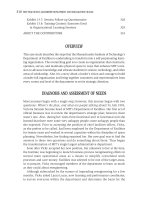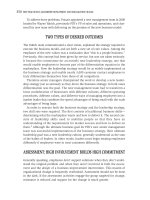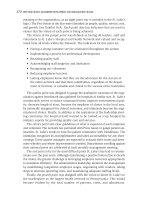Tài liệu Best Practives in Leadership Development & Organization Change 49 docx
Bạn đang xem bản rút gọn của tài liệu. Xem và tải ngay bản đầy đủ của tài liệu tại đây (143.44 KB, 10 trang )
savings to gaining consensus on a project that led to tangible business results
to customer satisfaction to financial results and even to shareholder value.
SUMMARY
Only those who dare to fail greatly, can ever achieve greatly.
—Robert F. Kennedy
7
The summary results underscored the critical importance of senior management
support. These data did not disregard the crucial role of participants in design-
ing the program itself, thus supporting the need for employees at all levels of
the organization to be active and equal partners and players in leadership devel-
opment and change. All of our data suggest that the more involvement, under-
standing, and respect given to the diverse needs and styles of employees at all
levels, the lower the resistance to change. In addition, there seems to be
450
BEST PRACTICES IN LEADERSHIP DEVELOPMENT AND ORGANIZATION CHANGE
Table 19.12. Positive Results of Initiatives, in Order of Percentage Frequency
Positive Results Frequency (%)
Organizational effectiveness (e.g., communication, 87
consensus building, project planning)
Strategic imperatives fulfilled 73
Team performance 67
Cost savings 53
Customer satisfaction 33
Financial results 27
Shareholder value 7
Table 19.11. Evaluation Method Usage
Evaluation Method Usage Ranking
Behavioral change evaluation 1
Organization assessments, surveys, tracking 2
ROI calculations 3
Results evaluation 4
Feedback sessions 5
cart_14399_ch19.qxd 10/19/04 1:20 PM Page 450
increased value derived from building on existing systems and involving all
levels of employees in the development of new processes, both of which help
truly integrate change initiatives into the organization’s culture.
The top-ranking critical success factors included
1. Support and participation of senior management
2. Connecting development and the initiative with the strategic plan
3. Involvement of participants in design
4. Integration with other divisional processes, practices, or systems
5. Pilot program before launch
6. Continuous evaluation
7. Leveraging of internal capacity
Having employees become more involved in the development of the initia-
tives directly addresses some of the most significant challenges, such as fear of
the unknown, aversion to loss of control, and of course aversion to change.
Building on existing successful systems helps reduce the sense of mistrust that
comes from “initiatives of the month.”
There is no doubt that these best practice organizations both endured strug-
gles and enjoyed rewards, but what is even more certain is that they will con-
tinue to strive toward increasing organizational effectiveness through innovative,
results-oriented, and integrated multilayered leadership development and change
initiatives. Louis Carter, his co-editors David Ulrich and Marshall Goldsmith,
and the Best Practices Institute look forward to continuing their work with the
world’s best organizations, which are passionate about positive change and
leadership development.
NOTES
1. H. D. Thoreau. Civil Disobedience, Solitude: And Life Without Principle.
Minneapolis, Minn.: Prometheus Books, 1998.
2. R. Carter (b. 1928). United States First Lady, wife of Jimmy Carter.
3. I. Gandhi, quoted by Christian Science Monitor, May 17, 1982.
4. George Eliot was the pseudonym of novelist, translator, and religious writer Mary
Ann Evans (1819–1880).
5. R. Beckhard and R. Harris. Organizational Transitions. Reading, Mass.: Addison-
Wesley, 1977, p. 86.
6. W. J. Rothwell, R. Sullivan, and G. N. McLean. Practicing Organization Develop-
ment: A Guide for Consultants. San Francisco: Jossey-Bass, 1995, p. 313.
7. R. F. Kennedy, “Day of Affirmation Address,” University of Capetown, South
Africa, June 6, 1966.
CONCLUSION
451
cart_14399_ch19.qxd 10/19/04 1:20 PM Page 451
cart_14399_ch19.qxd 10/19/04 1:20 PM Page 452
ABOUT THE BEST PRACTICES INSTITUTE
T
he Best Practices Institute (BPI) and Best Practice Publications were
founded by Louis Carter in New York City just after September 11, 2001,
while Carter was a graduate student at Columbia University. BPI was
formed to bring the best-thought leadership and research in the field of organi-
zation and social change to leaders of governments, social systems, nonprofit
organizations, and for-profit organizations in an increasingly complex and
chaotic world. In order to achieve this goal, Carter—with the help of a team of
five interns from Columbia University’s MBA and Social/Organizational Psy-
chology program—recruited a panel of twenty-three experts in the field of lead-
ership and organization development and eighteen best practice organizations to
form the basis of the Change Champion’s Model for meaningful change and
to complete the research behind this book.
Carter’s Change Champion’s Model is based on the assumption that only
through a deep and profound exploration and understanding of one’s own and
others’ life experiences and perspectives is true positive social, personal,
and organizational change accomplished. Carter’s book with Best Practice Pub-
lications and the Best Practices Institute, entitled The Change Champion’s Field-
guide, received praise from sources in the People’s Republic of China, India,
and America. Vijay Govindarajan, professor of international business and direc-
tor of the Center for Global Leadership at the Tuck School of Business at
Dartmouth College, endorsed the book by saying, “The Change Champion’s
Fieldguide will become one of the most quoted, referenced, and used business
books in the first decade of the 2000s.” Professor Li Jianfeng, Ph.D., of the
S
S
453
cart_14399_babout.qxd 10/20/04 12:45 PM Page 453
454
ABOUT THE BEST PRACTICES INSTITUTE
Renmin University School of Business and Cisun Academy of Management in
Beijing translated the book into Mandarin and Cantonese and published the
book through Huaxia Publishing House (Beijing) for distribution throughout
all provinces of China. Dr. Debi Saini, professor of leadership at the Manage-
ment Development Institute in Gurgaon, India, is currently bringing the book
and its teachings to the Indian market.
Louis Carter’s Best Practices Institute and Change Champion thought leaders
include David Cooperrider, Jerry Sternin, David Ulrich, Mary Eggers, Marshall
Goldsmith, Dr. John Sullivan, Ryan Matthews, Stu Noble, William Rothwell,
and Larry Susskind. The Change Champion’s Model and several BPI work-
shops have been presented by Louis Carter in Singapore, Bangkok, Beijing, and
at American universities and corporations.
For more information on the Best Practices Institute and Best Practice
Publications, visit or contact Louis Carter directly
at
Louis Carter, CEO
Best Practices Institute, LLC
25 Crescent Street
Suite 531
Waltham, Massachusetts 02453
customer support: lcarter
@
bpinstitute.net
888-895-8949
For international calls, please see our Website for details.
LOUIS CARTER’S
cart_14399_babout.qxd 10/20/04 12:45 PM Page 454









